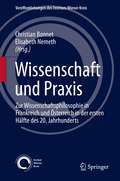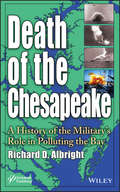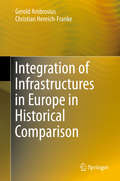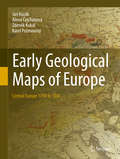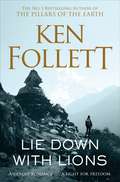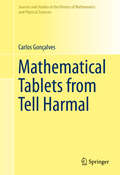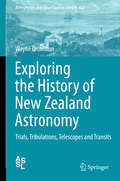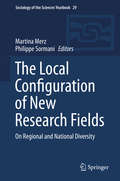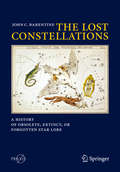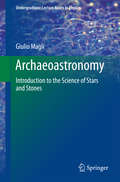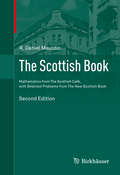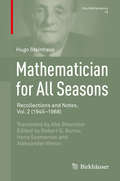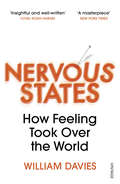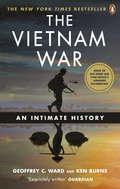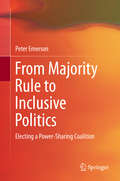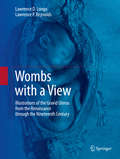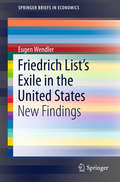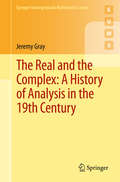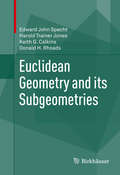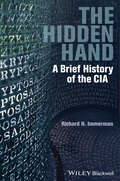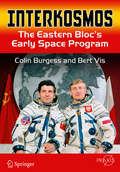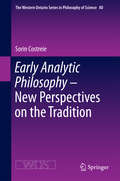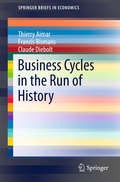- Table View
- List View
Wissenschaft und Praxis: Zur Wissenschaftsphilosophie in Frankreich und Österreich in der ersten Hälfte des 20. Jahrhunderts (Veröffentlichungen des Instituts Wiener Kreis #22)
by Christian Bonnet Elisabeth NemethDie Wissenschaftsphilosophie des frühen 20. Jahrhunderts ist reichhaltiger und differenzierter in ihren Standpunkten als lange vermutet. Die Autoren zeigen das anhand der nur teilweise erforschten Interaktion zwischen den Wissenschaftsphilosophen des deutschen und französischen Sprachraums. Das Buch liefert neue Erkenntnisse zur Rolle der Philosophiekongresse in Prag 1934 und Paris 1937 sowie zur Bedeutung einzelner Akteure wie Marcel Boll, der die Rezeption des Logischen Empirismus in Frankreich beförderte. Die Spuren, die Ernst Mach, aber auch der weniger bekannte deutsche Physiologe und Hirnforscher Ewald Hering in der französischen Wissenschaftsphilosophie hinterließen, verfolgen die Autoren bis hin zu den Ideen Jean Piagets. Im Mittelpunkt des Buchs stehen Philosophen aus Frankreich, Deutschland und Österreich und ihre Leistung, die Wissenschaften nicht nur erkenntnistheoretisch und logisch durchleuchtet, sondern auch erkannt zu haben, dass ihre theoretische Struktur nur dann vollständig erfasst werden kann, wenn ihre praktische Dimension mit einbezogen wird. Dafür steht Henri Poincaré, der die tragende Rolle der Konventionen für die Theoriebildung in der Mathematik herausstellte. Sichtbar wird der Bezug zur Praxis auch in Moritz Schlicks Überlegungen zu einer auf Empirie basierenden Ethik oder in der Arbeit Otto Neuraths, der eine aus den modernen Wissenschaften gewonnene Konzeption menschlichen Erkennens für das Projekt der gesellschaftlichen Aufklärung fruchtbar machen wollte.
Death of the Chesapeake: A History of the Military's Role in Polluting the Bay
by Richard AlbrightIn essence this book deals with an area that contributes significantly to the pollution and degradation of Chesapeake Bay, but has been completely overlooked in many of the efforts to restore the Bay, specifically, the federal military pollution sources. The book also recognizes for the first time, that efforts to restore the Bay have failed because of violation of a fundamental precept of environmental cleanup; that is, to sample the site and see what is there. The Bay itself has never been sampled. Thus this book presents a view of the environmental condition of Chesapeake Bay that is totally unique. It covers a part of the history of the Bay that is not widely known, including how the Bay was formed. It presents a mixture of science, military history, and novel solutions to the Bay's degradation. In so doing, the author examines the military use of the Bay and reveals the extent of munitions dumpsites containing nitrogen and phosphorus as well as chemical warfare material, and how this is effecting the environment. The book concludes with the author's own clean-up plan that, if implemented, would go a long way to restoring health to Bay. The book is supplemented with many photographs and maps.
Integration of Infrastructures in Europe in Historical Comparison
by Gerold Ambrosius Christian Henrich-FrankeThis book compares the cross-border integration of infrastructures in Europe such as post, telecommunication and transportation in the 19th century and the period following the Second World War. In addition to providing a unique perspective on the development of cross-border infrastructures and the international regimes regulating them, it offers the first systematic comparison of a variety of infrastructure sectors, identifies general developmental trends and supplies theoretical explanations. In this regard, integration is defined as international standardization, network building and the establishment of international organizations to regulate cross-border infrastructures.
Early Geological Maps of Europe: Central Europe 1750 to 1840
by Jan Kozák Alena Čejchanová Zdeněk Kukal Karel PošmournýThis book focuses on the presentation and evaluation of geological maps of the Central Europe from 1750 up to 1840. Milestones in presentation of stratigraphy and tectonics and new geological models on such maps will be underlined. Map descriptions contain fundamentals editorial data as well as the map author’s affiliation and biographies. It represents for the region of the Central Europe the first work of this type. Geological maps represent geological synthesis and indicate the level of geological knowledge throughout history. They serve as guidelines for an economic utilization of mineral deposits and further geological investigation.
Lie Down With Lions
by Ken FollettLie Down With Lions is the thrilling tale of suspense and deceit from master of the spy story, Ken Follett.A Dangerous RomanceIn Paris, rival spies Ellis and Jean-Pierre both fall in love with Jane, and all three become gripped in a tangled web of lust and deception as they battle terrorist conspiracies. Ultimately Jane can marry only one and chooses Jean-Pierre.A Fight for FreedomIn Afghanistan the Mujahedeen are fighting to free their country of the Soviet invasion and the newlyweds travel to the Valley of the Five Lions to help the cause as doctors. Fierce fighting means they must find a way out of the line of fire. A Perilous EscapeHelp unexpectedly comes in the form of her husband’s nemesis, Ellis, and knowing both men have dangerous secrets, Jane must once again choose who to trust if she is to make her escape over one of the most remote mountain ranges in the world . . .
Mathematical Tablets from Tell Harmal (Sources and Studies in the History of Mathematics and Physical Sciences)
by Carlos GonçalvesThis work offers a re-edition of twelve mathematical tablets from the site of Tell Harmal, in the borders of present-day Baghdad. In ancient times, Tell Harmal was Šaduppûm, a city representative of the region of the Diyala river and of the kingdom of Ešnunna, to which it belonged for a time. These twelve tablets were originally published in separate articles in the beginning of the 1950s and mostly contain solved problem texts. Some of the problems deal with abstract matters such as triangles and rectangles with no reference to daily life, while others are stated in explicitly empirical contexts, such as the transportation of a load of bricks, the size of a vessel, the number of men needed to build a wall and the acquisition of oil and lard.This new edition of the texts is the first to group them, and takes into account all the recent developments of the research in the history of Mesopotamian mathematics. Its introductory chapters are directed to readers interested in an overview of the mathematical contents of these tablets and the language issues involved in their interpretation, while a chapter of synthesis discusses the ways history of mathematics has typically dealt with the mathematical evidence and inquires how and to what degree mathematical tablets can be made part of a picture of the larger social context. Furthermore, the volume contributes to a geography of the Old Babylonian mathematical practices, by evidencing that scribes at Šaduppûm made use of cultural material that was locally available. The edited texts are accompanied by translations, philological, and mathematical commentaries.
Exploring the History of New Zealand Astronomy: Trials, Tribulations, Telescopes and Transits (Astrophysics and Space Science Library #422)
by Wayne OrchistonDr. Orchiston is a foremost authority on the subject of New Zealand astronomy, and here are the collected papers of his fruitful studies in this area, including both those published many years ago and new material. The papers herein review traditional Maori astronomy, examine the appearance of nautical astronomy practiced by Cook and his astronomers on their various stopovers in New Zealand during their three voyagers to the South Seas, and also explore notable nineteenth century New Zealand observatories historically, from significant telescopes now located in New Zealand to local and international observations made during the 1874 and 1882 transits of Venus and the nineteenth and twentieth century preoccupation of New Zealand amateur astronomers with comets and meteors.New Zealand astronomy has a truly rich history, extending from the Maori civilization in pre-European times through to the years when explorers and navigators discovered the region, up to pioneering research on the newly emerging field of radio astronomy during WWII and in the immediate post-war years. A complete survey of a neglected but rich national astronomical history, this does the subject full and comprehensive justice.
The Local Configuration of New Research Fields: On Regional and National Diversity (Sociology of the Sciences Yearbook #29)
by Martina Merz Philippe SormaniThis new Yearbook addresses the question of how policy, place, and organization are made to matter for a new research field to emerge. Bringing together leading historians, sociologists, and organizational researchers on science and technology, the volume answers this question by offering in-depth case studies and comparative perspectives on multiple research fields in their nascent stage, including molecular biology and materials science, nanotechnology, and synthetic biology. The Yearbook brings to bear the lessons of constructivist ethnography and the “practice turn” in Science and Technology Studies (STS) more broadly on the qualitative, comparative, and critical inquiry of new research fields. In doing so, it offers unprecedented insights into the complex interplay of national research policies, regional clusters, particular research institutions, and novel research practices in and for any emerging field of (techno-)science. It systematically investigates national and regional differences, including the variable mobilization of such differences, and probes them for organizational topicality and policy relevance.
The Lost Constellations: A History of Obsolete, Extinct, or Forgotten Star Lore (Springer Praxis Books)
by John C. BarentineCasual stargazers are familiar with many classical figures and asterisms composed of bright stars (e.g., Orion and the Plough), but this book reveals not just the constellations of today but those of yesteryear. The history of the human identification of constellations among the stars is explored through the stories of some influential celestial cartographers whose works determined whether new inventions survived. The history of how the modern set of 88 constellations was defined by the professional astronomy community is recounted, explaining how the constellations described in the book became permanently “extinct.” Dr. Barentine addresses why some figures were tried and discarded, and also directs observers to how those figures can still be picked out on a clear night if one knows where to look. These lost constellations are described in great detail using historical references, enabling observers to rediscover them on their own surveys of the sky. Treatment of the obsolete constellations as extant features of the night sky adds a new dimension to stargazing that merges history with the accessibility and immediacy of the night sky.
Archaeoastronomy: Introduction to the Science of Stars and Stones (Undergraduate Lecture Notes in Physics)
by Giulio MagliThis book provides the first complete, easy to read, up-to-date account of the fascinating discipline of archaeoastronomy, in which the relationship between ancient constructions and the sky is studied in order to gain a better understanding of the ideas of the architects of the past and of their religious and symbolic worlds. The book is divided into three sections, the first of which explores the past relations between astronomy and people, power, the afterworld, architecture, and landscape. The fundamentals of archaeoastronomy are then addressed in detail, with coverage of the celestial coordinates; the apparent motion of the Sun, Moon, stars, and planets; observation of celestial bodies at the horizon; the use of astronomical software in archaeoastronomy; and current methods for making and analyzing measurements. The final section reviews what archaeoastronomy can now tell us about the nature and purpose of such sites and structures as Stonehenge, the Pyramids of Giza, Chichen Itza, the Campus Martius, and the Valley of the Temples of Agrigento. In addition, a set of exercises is provided that can be performed using non-commercial free software, e.g., Google Earth or Stellarium, and will equip readers to conduct their own research. Readers will find the book an ideal introduction to what has become a wide-ranging multidisciplinary science.
The Scottish Book: Mathematics from The Scottish Café, with Selected Problems from The New Scottish Book
by R. Daniel MauldinThe second edition of this book updates and expands upon a historically important collection of mathematical problems first published in the United States by Birkhäuser in 1981. These problems serve as a record of the informal discussions held by a group of mathematicians at the Scottish Café in Lwów, Poland, between the two world wars. Many of them were leaders in the development of such areas as functional and real analysis, group theory, measure and set theory, probability, and topology. Finding solutions to the problems they proposed has been ongoing since World War II, with prizes offered in many cases to those who are successful.In the 35 years since the first edition published, several more problems have been fully or partially solved, but even today many still remain unsolved and several prizes remain unclaimed. In view of this, the editor has gathered new and updated commentaries on the original 193 problems. Some problems are solved for the first time in this edition. Included again in full are transcripts of lectures given by Stanislaw Ulam, Mark Kac, Antoni Zygmund, Paul Erdös, and Andrzej Granas that provide amazing insights into the mathematical environment of Lwów before World War II and the development of The Scottish Book. Also new in this edition are a brief history of the University of Wrocław’s New Scottish Book, created to revive the tradition of the original, and some selected problems from it.The Scottish Book offers a unique opportunity to communicate with the people and ideas of a time and place that had an enormous influence on the development of mathematics and try their hand on the unsolved problems. Anyone in the general mathematical community with an interest in the history of modern mathematics will find this to be an insightful and fascinating read.
Mathematician for All Seasons: Recollections and Notes, Vol. 2 (1945–1968) (Vita Mathematica #19)
by Hugo SteinhausThis book presents, in his own words, the life of Hugo Steinhaus (1887–1972), noted Polish mathematician of Jewish background, educator, and mathematical popularizer. A student of Hilbert, a pioneer of the foundations of probability and game theory, and a contributor to the development of functional analysis, he was one of those instrumental to the extraordinary flowering of Polish mathematics before and after World War I. In particular, it was he who “discovered” the great Stefan Banach. Exhibiting his great integrity and wit, Steinhaus’s personal story of the turbulent times he survived – including two world wars and life postwar under the Soviet heel – cannot but be of consuming interest. His recounting of the fearful years spent evading Nazi terror is especially moving. The steadfast honesty and natural dignity he maintained while pursuing a life of demanding scientific and intellectual enquiry in the face of encroaching calamity and chaos show him to be truly a mathematician for all seasons.The present work will be of great interest not only to mathematicians wanting to learn some of the details of the mathematical blossoming that occurred in Poland in the first half of the 20th century, but also to anyone wishing to read a first-hand account of the history of those unquiet times in Europe – and indeed world-wide – by someone of uncommon intelligence and forthrightness situated near an eye of the storm.
Nervous States: How Feeling Took Over the World
by William DaviesWhy do we no longer trust experts, facts and statistics?Why has politics become so fractious and warlike?What caused the populist political upheavals of recent years?How can the history of ideas help us understand our present? In this bold and far-reaching exploration of our new political landscape, William Davies reveals how feelings have come to reshape our world. Drawing deep on history, philosophy, psychology and economics, he shows how some of the fundamental assumptions that defined the modern world have dissolved. With advances in science and medicine, the division between mind and body is no longer so clear-cut. The spread of digital and military technology has left us not quite at war nor exactly at peace. In the murky new space between mind and body, between war and peace, lie nervous states: with all of us relying increasingly on feeling rather than fact. In a book of profound insight and astonishing breadth, William Davies reveals the origins of this new political reality. Nervous States is a compelling and essential guide to the turbulent times we are living through.
The Vietnam War: An Intimate History
by Geoffrey C. Ward Ken BurnsThis definitive account is perfect for any history-buff this Father’s day.**The New York Times Bestseller****The book of the landmark documentary, The Vietnam War, by Ken Burns and Lynn Novick**The definitive work on the Vietnam War, the conflict that came to define a generation, told from all sides by those who were there.More than forty years after the Vietnam War ended, its legacy continues to fascinate, horrify and inform us. As the first war to be fought in front of TV cameras and beamed around the world, it has been immortalised on film and on the page, and forever changed the way we think about war.Drawing on hundreds of brand new interviews, Ken Burns and Geoffrey C. Ward have created the definitive work on Vietnam. It is the first book to show us the war from every perspective: from idealistic US Marines and the families they left behind to the Vietnamese civilians, both North and South, whose homeland was changed for ever; politicians, POWs and anti-war protesters; and the photographers and journalists who risked their lives to tell the truth. The book sends us into the grit and chaos of combat, while also expertly outlining the complex chain of political events that led America to Vietnam.Beautifully written, this essential work tells the full story without taking sides and reminds us that there is no single truth in war. It is set to redefine our understanding of a brutal conflict, to launch provocative new debates and to shed fresh light on the price paid in ‘blood and bone’ by Vietnamese and Americans alike.
From Majority Rule to Inclusive Politics: Electing A Power-sharing Coalition
by Peter EmersonThis book discusses voting procedures in collective decision-making. Drawing on well-established election processes from all over the world, the author presents a voting procedure that allows for the speedy but fair election of a proportional, all-party coalition. The methodology - a matrix vote - is accurate, robust and ethno-color blind. In the vote, the counting procedure encourages all concerned to cross the gender as well as any party and/or sectarian divides. While in the resulting executive each party will be represented fairly and, at best, with the consensus of parliament, every minister will be the one most suited to his/her new portfolio. By using preferential voting and thus achieving consensus, the matrix vote will be fundamental to the resolution of conflicts.The matrix vote can also be used when:• two or more parliamentary parties elect a coalition government• one parliamentary party elects a government or shadow cabinet, or organizations in civil society elect their governing boards or executive committees• any group chooses a fixed number of individuals to form a team in which each member carries out a different function
Wombs with a View: Illustrations of the Gravid Uterus from the Renaissance through the Nineteenth Century
by Lawrence D. Longo Lawrence P. ReynoldsThe volume provides an archive of some of the most beautiful illustrations ever made of the gravid uterus with fetus and placenta, which will serve future generations of investigators, educators, and students of reproduction. The approximately two hundred figures from over one hundred volumes included are from the late fifteenth through the nineteenth century. For each author whose work is depicted in this volume, we have used the first edition or first illustrated edition. In the commentary, each volume and illustration is placed in its historical perspective, noting both the significance of that image, but also some background on the life and work of the author. For most of the works cited, there are additional references for the reader who may wish to explore these in greater depth. This volume is a unique collection not only of these historical images, but also their place in the development of scientific study.
Friedrich List’s Exile in the United States: New Findings (SpringerBriefs in Economics)
by Eugen WendlerThis book presents new findings on the biography of Friedrich List, one of the world’s most important and popular economists. Following List's tracks in Pennsylvania and discussing several new sources, the author, Eugen Wendler, focuses on List's life and exile in the United States between 1825 and 1832. This richly illustrated book is as informative as it is well written. The author is a respected expert on the life and work of Friedrich List.
The Real and the Complex: A History of Analysis in the 19th Century (Springer Undergraduate Mathematics Series)
by Jeremy GrayThis book contains a history of real and complex analysis in the nineteenth century, from the work of Lagrange and Fourier to the origins of set theory and the modern foundations of analysis. It studies the works of many contributors including Gauss, Cauchy, Riemann, and Weierstrass.This book is unique owing to the treatment of real and complex analysis as overlapping, inter-related subjects, in keeping with how they were seen at the time. It is suitable as a course in the history of mathematics for students who have studied an introductory course in analysis, and will enrich any course in undergraduate real or complex analysis.
France, 1815-2003: Modern History For Modern Languages (PDF)
by Martin EvansMODERN HISTORY FOR MODERN LANGUAGES FRANCE 1815-2003 Written in an accessible style and assuming no prior knowledge, the books in this series address the specific needs of students on language courses. Approaching the study of history from an interest in contemporary politics and society, each book offers a clear historical narrative and sets its region into a world context. Chronological in approach, France 1815-2003 focuses on the main events in French political history, including major socio-economic themes where relevant. Events include the French Revolution, the Bourbon Restoration, the July Monarchy, the Second Republic and the Second Empire, The Third Republic, Occupied France, The Fourth Republic, The Gaullist Revolution, After De Gaulle: Pompidou and Giscard and From 'La Grande Alternance' to 'Normalization'. Drawing upon the latest research, particular emphasis has been given to the role of political memory, the contribution of women and the impact of colonialism and post-colonialism. A range of pedagogical devices and a lively prose style ensure that the book is tailor-made to the requirements of French language undergraduates. The book includes: . timelines of main events at the start of each chapter . glossary-style inserts concentrating on non-official perspectives to show the ways in which history has impacted upon the lives of ordinary people .topics for discussion .a selection of original documents including songs, posters, diaries and eye-witness accounts The book will be supplemented by a specialised web-site that will include links, interviews with key historians and further documents.
France, 1815-2003: Modern History For Modern Languages
by Martin EvansMODERN HISTORY FOR MODERN LANGUAGES FRANCE 1815-2003 Written in an accessible style and assuming no prior knowledge, the books in this series address the specific needs of students on language courses. Approaching the study of history from an interest in contemporary politics and society, each book offers a clear historical narrative and sets its region into a world context. Chronological in approach, France 1815-2003 focuses on the main events in French political history, including major socio-economic themes where relevant. Events include the French Revolution, the Bourbon Restoration, the July Monarchy, the Second Republic and the Second Empire, The Third Republic, Occupied France, The Fourth Republic, The Gaullist Revolution, After De Gaulle: Pompidou and Giscard and From 'La Grande Alternance' to 'Normalization'. Drawing upon the latest research, particular emphasis has been given to the role of political memory, the contribution of women and the impact of colonialism and post-colonialism. A range of pedagogical devices and a lively prose style ensure that the book is tailor-made to the requirements of French language undergraduates. The book includes: . timelines of main events at the start of each chapter . glossary-style inserts concentrating on non-official perspectives to show the ways in which history has impacted upon the lives of ordinary people .topics for discussion .a selection of original documents including songs, posters, diaries and eye-witness accounts The book will be supplemented by a specialised web-site that will include links, interviews with key historians and further documents.
Euclidean Geometry and its Subgeometries
by Edward John Specht Harold Trainer Jones Keith G. Calkins Donald H. RhoadsIn this monograph, the authors present a modern development of Euclidean geometry from independent axioms, using up-to-date language and providing detailed proofs. The axioms for incidence, betweenness, and plane separation are close to those of Hilbert. This is the only axiomatic treatment of Euclidean geometry that uses axioms not involving metric notions and that explores congruence and isometries by means of reflection mappings. The authors present thirteen axioms in sequence, proving as many theorems as possible at each stage and, in the process, building up subgeometries, most notably the Pasch and neutral geometries. Standard topics such as the congruence theorems for triangles, embedding the real numbers in a line, and coordinatization of the plane are included, as well as theorems of Pythagoras, Desargues, Pappas, Menelaus, and Ceva. The final chapter covers consistency and independence of axioms, as well as independence of definition properties. There are over 300 exercises; solutions to many of these, including all that are needed for this development, are available online at the homepage for the book at www.springer.com. Supplementary material is available online covering construction of complex numbers, arc length, the circular functions, angle measure, and the polygonal form of the Jordan Curve theorem. Euclidean Geometry and Its Subgeometries is intended for advanced students and mature mathematicians, but the proofs are thoroughly worked out to make it accessible to undergraduate students as well. It can be regarded as a completion, updating, and expansion of Hilbert's work, filling a gap in the existing literature.
The Hidden Hand: A Brief History of the CIA
by Richard H. ImmermanThe Hidden Hand is a succinct accessible and up-to-date survey of the Central Intelligence Agency’s history from its inception in 1947 to the present. Covers both aspects of the CIA’s mission – the collection and analysis of intelligence and the execution of foreign policy through covert, paramilitary operations De-mythologizes the CIA’s role in America’s global affairs while addressing its place within American political and popular culture Written by an esteemed scholar and high-ranking officer in the intelligence community, drawing on the latest research Assesses the agency’s successes and failures, with an eye to the complex and controversial nature of the subject
Interkosmos: The Eastern Bloc's Early Space Program (Springer Praxis Books)
by Colin Burgess Bert VisThis book focuses on the Interkosmos program, which was formed in 1967, marking a fundamentally new era of cooperation by socialist countries, led by the Soviet Union, in the study and exploration of space. The chapters shed light on the space program that was at that time a prime outlet for the Soviet Union's aims at becoming a world power. Interkosmos was a highly publicized Russian space program that rapidly became a significant propaganda tool for the Soviet Union in the waning years of communism. Billed as an international “research-cosmonaut” imperative, it was also a high-profile means of displaying solidarity with the nine participating Eastern bloc countries. Those countries contributed pilots who were trained in Moscow for week-long “guest” missions on orbiting Salyut stations. They did a little subsidiary science and were permitted only the most basic mechanical maneuvers.In this enthralling new book, and following extensive international research, the authors fully explore the background, accomplishments and political legacy of the Interkosmos program. Through personal and often highly revealing interviews with many of the participants they relate the very human story behind this extraordinary but controversial space venture..
Early Analytic Philosophy - New Perspectives on the Tradition: New Perspectives On The Tradition (The Western Ontario Series in Philosophy of Science #80)
by Sorin CostreieThis volume discusses some crucial ideas of the founders of the analytic philosophy: Gottlob Frege, Bertrand Russell and Ludwig Wittgenstein, or the ‘golden trio’. The book shows how these ‘old’ ideas are still present and influential in the current philosophical debates and to what extent these debates echo the original ideas. The collection aim is twofold: to better understand these fruitful ideas by placing them in the original setting, and to systematically examine these ideas in the context of the current debates animating philosophical discussions today. Divided into five sections, the book first sets the stage and offers a general introduction to the background influences, as well as delimitations of the initial foundational positions. This first section contains two papers dedicated to the discussion of realism and the status of science at that time, followed by two papers that tackle the epistemic status of logical laws. The next three sections constitute the core of the volume, each being dedicated to the most important figures in the early analytic tradition: Frege, Russell, and Wittgenstein. The last section gathers several essays that discuss either the relation between two or more analytic thinkers, or various important concepts such as ‘predicativism’ and ‘arbitrary function’, or the principles of abstraction and non-contradiction.
Business Cycles in the Run of History (SpringerBriefs in Economics)
by Thierry Aimar Francis Bismans Claude DieboltThis book analyzes the development of economic cycles in the run of history. The focus is on the development of cycle theory, with maximum emphasis upon ideas. Chapter 1 delivers an overview of the debate about cycles before the 1970s. Chapter 2 completes this survey by presenting the main empirical investigations since that time. Finally, Chapters 3 and 4 illustrate the discourse, by presenting, in the tradition of Burns and Mitchell, original case studies on France, South Africa, and Germany.
